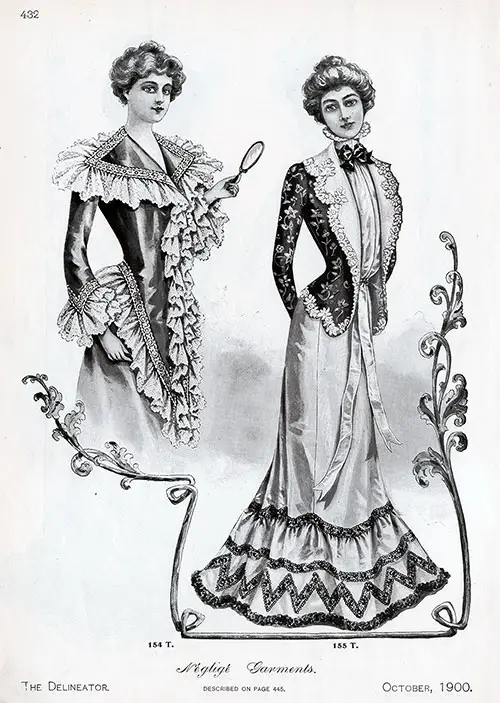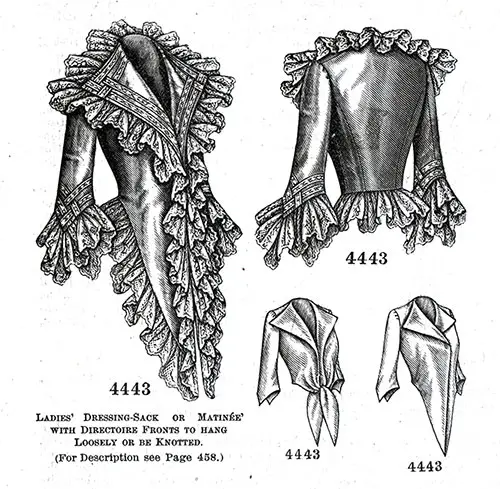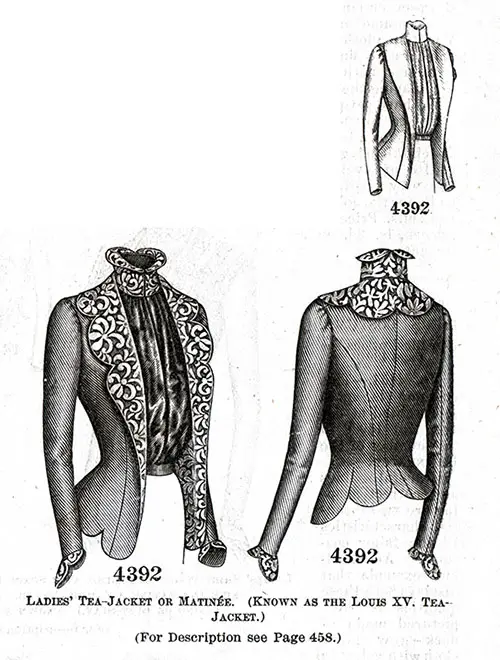Ladies Negligée Garments - 1900

Described on Page 445 | For Illustrations see Page 432
Ladies’ Matinée No. 154 T
This illustrates a Ladies’ dressing-sack or matinée.
Description
The lavish use of lace edging and insertion gives an elegant appearance to the simple design here illustrated made of pale-yellow silk.
The garment shows smooth adjustment at the sides and back, where it terminates at the waistline and possesses a novelty in the Directoire fronts that are turned back to form triangular revers, below which they hang loosely and taper to points considerably below the waist.
The neck is collarless and finished with the lace frill that is continued around all the free edges of the garment. The loose two-seam sleeves terminate in points just below the elbow and are exceptionally becoming and comfortable. The fronts may be knotted at the waistline if desired.
Dressmaker Options
A dainty sack could be made in this style of peach-colored surah silk with plaited chiffon frills for decoration. Fine lawn could also be employed with all-over embroidery or lace for facing the revers and edging for decoration.
Pattern Information
The pattern, which is No. 4443 and costs 10d. or 20 cents, is in five sizes for ladies from thirty-two to forty inches, bust measure, and is again portrayed on page 451.
Ladies’ Dressing-Sack or Matinee No. 4443

No. 4443 Ladies’ Dressing-Sack or Matinee with Directoire Fronts to Hang Loosely or be Knotted.
For Description see Page 458 | For Illustrations see Page 451
This sack is illustrated again in figure No. 154 T in this publication.
Description
A dressing-sack or matinee is almost an absolute necessity to comfort, and a mode combining ease and daintiness is sure to meet with approval.
The design here illustrated developed in pale-yellow India silk and decorated with frills of lace edging and rows of lace insertion has not only these excellent features but also that of simplicity of design.
The fronts are in Directoire style and are extended at the center in long tapering ends, that may fall free or be knotted loosely at the waist. They are secured at the bust by ribbon ties, and above are turned back in large triangular revers that give breadth to the figure and expose the neck in V outline.
If desired, the fronts may be lapped slightly in double-breasted style, as shown in one of the small views. The sack reaches to the waist at the sides and back, wide underarm gores and shoulder seams entering into the simple adjustment, and the seamless back is perfectly smooth.
The comfortably loose-fitting two-seam sleeves extend to the elbow where they flare in points. The mode is made without a collar.
Dressmaker Options
A charming dressing-sack could be evolved from Pompadour glace silk, and the decoration could be accordion-plaited ruffles of white chiffon. A dainty effect could be obtained by inserting a scarf of white chiffon in the armholes, at the front, and knotting carelessly with flowing ends at the bust.
Other materials appropriate for the development are louisine, crepe de Chine, Liberty satin, Henrietta, nun's veiling, etc., and the decoration could consist of 6elf-ruffles and shirred ribbon.
Pattern Information
We have pattern No. 4443 in five sizes for ladies from thirty-two to forty inches, bust measure.
To make the dressing-sack for a lady of medium size requires three yards and one-half of goods twenty inches wide.
Price of pattern, 10d. or 20 cents.
Ladies' Tea-Jacket and Petticoat-Skirt No. 155 T

Figure No. 155 T.—Ladies' Tea-Jacket and Petticoat-Skirt. —This unites a Ladies’ tea-jacket and petticoat-skirt.
Description
An attractive matinee, known as the Louis XV tea-jacket, and a petticoat-skirt of graceful shaping are pictured at this figure. The tea-jacket is developed in a combination of figured crepe de Chine and plain silk with ribbon and bands of applique for garniture.
The garment is carefully adjusted at the sides and back and has dart-fitted fronts that flare all the way over a full vest that reaches to the waist.
The fronts are turned back in scalloped, tapering revers that are extended to the center of the back to form a flat collar, and the jacket is scalloped at the lower edge.
Turn-over portions top the standing collar which finishes the neck, and the close-fitting sleeves are completed with scalloped cuffs.
The five-gored petticoat-skirt is without any fullness at the top and is admirable for wear with skirts that are adjusted carefully about the hips.
A distinguishing feature of the mode is the flounce, which consists of a straight, full ruffle gathered at the top and finished at the lower edge with a rippling, circular ruffle. The petticoat-skirt is shown made of light-blue silk with black lace insertion for the decoration.
Dressmaker Options
Fine flannel, Liberty or India silk, Lansdowne, cashmere, etc., will develop dainty tea-jackets by the mode, and the petticoat-skirt may be of moreen, mohair, cambric or mercerized satin with braid, piping, folds, plaiting, ruchings, narrow frills and lace insertion and edging for decoration.
Pattern Information
The tea jacket pattern, which is No. 4392 and costs 10d. or 20 cents, is in eight sizes for ladies from thirty to forty-four inches, bust measure, and is again pictured on page 450.
The petticoat-skirt pattern, which is No. 3906 and costs 10d. or 20 cents, is in nine sizes from twenty to thirty-six inches, waist measure.
Ladies’ Tea-Jacket or Matinee No. 4392

Ladies’ Tea-Jacket or Matinee. (Known as the Louis XV Tea-Jacket.)
For Description see Page 458 | For Illustrations see Page 450
This jacket is illustrated again in figure No. 155 T in this magazine.
Description
A handsome tea-jacket that will undoubtedly find a welcome place in the feminine wardrobe is here shown in a combination of gray cashmere, black silk, and all-over lace.
The mode, which is sometimes called the Louis XV tea-jacket, is carefully adjusted at the back and sides and the lower edge may be scalloped or plain.
The fronts are dart-fitted and flare attractively all the way to disclose the vest; they are turned back in scalloped, tapering revers that are extended at the top to the center of the back to form a flat collar, and both the collar and revers may be plain if liked.
The vest is gathered at the top and bottom and is arranged over the fitted lining-fronts; it terminates at the waistline, where it pouches slightly and closes at the center.
A high standing collar topped by turn-over portions is at the neck, and the closely adjusted two-seam sleeves are completed with flaring cuffs. A band of ribbon crosses the bottom of the vest.
Dressmaker Options
Nile-green Lansdowne combined with white China silk and ecru all-over lace will result in a stunning tea-jacket. Surah or China silk, fine French flannel, albatross, Henrietta, etc., are also suitable fabrics, and if less elaborateness be desired the all-over lace may be omitted.
Pattern Information
We have pattern Ho. 4392 in eight sizes for ladies from thirty to forty-four inches, bust measure.
To make the tea-jacket for a lady of medium size will require a yard and three-fourths of material forty-four inches wide with a yard and three-fourths of silk twenty inches wide for the vest, cuffs, collar, collar ornaments, and for facing the revers, and a yard and one-fourth of all-over lace twenty inches wide to cover the revers, cuffs, collar and collar ornaments.
Price of pattern, 10d. or 20 cents.
Terminology
Basque: A basque is an item of women's clothing. The term, of French origin, formerly referred to types of bodice or jacket with long tails, and in later usage a long corset, characterized by a close, contoured fit and extending past the waistline over the hips. It is so called because the original French fashion for long women's jackets was adopted from traditional Basque dress. (Wikipedia)
Negligée: a woman's light dressing gown, typically made of a filmy, soft fabric. (Oxford University Press)
Bodice: the close-fitting upper part of a dress, covering the chest and back above the waist. (Oxford University Press)
"Descriptions of Figures in Colors, Tints, Etc., Shown on First Page of Cover and Pages 423 to 437 Inclusive," in The Delineator: An Illustrated Magazine of Literature and Fashion, Paris-London-New York: The Butterick Publishing Co. Ltd., Vol. LVI, No. 4, October 1900, p. 432, 445, 450-451, 458.
Editor's Note: Some terminology used in the description of women's clothing during the 1800s and early 1900s has been changed to reflect more modern terms. For example, a women's "Toilette" -- a form of costume or outfit has an entirely different common meaning in the 21st century. Typical terms applied to "toilette" include outfit, ensemble, or costume, depending on context.
Note: We have edited this text to correct grammatical errors and improve word choice to clarify the article for today’s readers. Changes made are typically minor, and we often left passive text “as is.” Those who need to quote the article directly should verify any changes by reviewing the original material.

